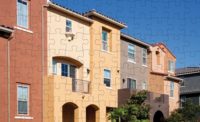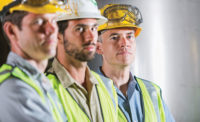EIFS, Here to Save the Day














Now that we have this “new energy code” that went into effect Sept. 1, in Texas to make buildings more energy efficient, it’s in our face. The task was placed on design professionals and the construction industry to develop new ways in wall assemblies to conserve energy. It’s a good idea and long overdue. It’s all about being more conservative about what we waste, energy and money. It’s kind of like the green movement or LEED. Buildings generate up to 35 percent of all greenhouse gases, 35 percent of landfill waste comes from construction and demolition activities, and 70 percent of municipal water is consumed in and around buildings.
Construction projects building to the LEED concept have strict criteria to gain this honor. Recycling of scrap or unused cut off materials, natural light and even cisterns (tanks) to recover rain water just to name a few. LEED buildings are energy efficient but energy efficient buildings are not necessarily LEED.
Most of us are familiar with the terms “thermal bridging”, “thermal short circuit” or “thermal transfer”. I’m going to tell you a little more about it, show it to you and show y’all why continuous insulation (CI), aka EIFS is the closest exterior cladding to comply with this energy code.
Back in the early ’80s when I first started in this business, EIFS was not very popular and fairly new in the market. In fact, I remember only two products on the market and the finish sold for $68.00 per pail. In one respect EIFS was not popular with me because I am a lather by trade. There is no lath in the system. We feared it would take our jobs and the “old timers” of that day preached it was a temporary wall system. I was working for a big contractor from Dallas I’ll refer to as Joe Mac. Anyone in the plastering business in Texas knew Joe Mac. He was a big player. He had an automated facility that produced pre-fabricated wall panels. They were made in Dallas short of the finish coat, shipped to Houston, finished on a bench and hoisted into place with a crane.
The deal with the union iron workers and lather’s local 224 was anything heavier than 14 gauge metal was their work and lighter belonged to the lathers. All exterior framing back then was 16 gauge materials and believe it or not, they weren’t galvanized. The fear of no work was not an issue anymore because this agreement made it our work. Joe Mac also produced cement asbestos board panels with heavy aggregate that were imbedded in epoxy. This was intended to replicate MarbleCrete, which was popular at the time. This is what started to get everyone’s attention to thermal transfer.
I didn’t notice what was happening until the early ’90’s. Joe Mac had done a dozen or more buildings in Houston. I’m the type of guy that remembers each project I worked on and when I would drive past one I would take a look. What I noticed was that in the mornings, summer or winter, when the inside and outside temperatures greatly differ you could see every stud through the CAB panels. What happens is there’s no insulation between the face of the studs and sheetrock inside and the face of the studs and sheathing outside. This creates a bridge in which energy travels. I am sure many of you have seen the same thing and so have all the engineers that are trying to develop systems that meet the new codes.
The masonry industry has not yet figured out what to do. There are new products being developed and tested. Brick ties surrounded with insulation is attached to the structure and thus a bridge. Assemblies with Z metal over CMU and XPS in between still has a bridge. The glazing industry is scratching their head because even with three panes of glass for thermal break, half of the frame is interior and half exterior which creates a bridge. The vinyl and wood siding industry have almost no chance to figure this out because they must attach to framing or sheathing attached to framing creating a small bridge but a bridge nonetheless. Tilt panels? The entire system is a thermal bridge. The stucco industry has tested stucco over continuous insulation but we still have to attach to the frame through the EPS.
Small attachments promote energy loss. Even with CI behind the finish wall system any fasteners that penetrate create a “short circuit” or path for energy loss. The engineered metal building industry is developing new systems. I have seen one such design. I believe EIFS are more cost effective.
Bridge Out Ahead
Let me reintroduce you to our little friend, Exterior Insulation Finish System. EIFS was developed as a remedy to patch the masonry buildings in Europe shot up during WWII by the Germans that were salvageable. It has many benefits and the biggest, aside from versatility, is insulation on the outside of the wall assembly. The EIFS Industry Member’s Association in conjunction with the Oakridge National Laboratory (ORNL) did a seven year test on wall assemblies of different claddings to determine what had the best performance for controlling energy loss. ORNL is an American multiprogramming science and technology national laboratory managed for the United States Department of Energy (DOE) by UT-Battelle. ORNL is the largest science and energy national laboratory in the Department of Energy system by surface and by annual budget. ORNL is located in Oak Ridge, Tennessee, near Knoxville. ORNL’s scientific programs focus on materials, neutron science, energy, high-performance computing, systems biology and national security.
A three-phase study of the thermal and moisture control characteristics of exterior insulation and finish systems was initiated and funded through the U.S. Department of Energy and in part by the nonprofit trade group EIFS Industry Members Association. The study was conducted independently by the Oak Ridge National Laboratory. In short, the results confirm that EIFS performs better than brick wall cladding in terms of energy efficiency and moisture control. This is provided that a vapor barrier, if used, is properly located within the wall, for the construction climate zone, and water intrusion is prevented by proper construction and maintenance. EIFS was the victor running away from the pack. The complete study can be viewed and downloaded from EIMA’s website.
Uninterrupted insulation or continuous insulation that is adhesively attached in conjunction with an air barrier compatible and tested with a particular EIF system does not promote any measurable energy loss. Attached to sheathing, masonry or non-painted stucco it not only complies with the energy code it pretty much sets the bench mark.
The Europeans and particularly the Canadians are further advanced in their building science technology than the United States. They are both full steam ahead with using EIFS as the exterior cladding of choice. Canada’s spring and summer consists of six to eight weeks. Europe’s is pretty parallel with the NE USA. Europe had only a few R&D and manufacturing facilities a dozen years ago. Today, there are scores of them throughout Europe because of the demand for the products. They have been installing up to 10-inches of EPS on exteriors for five years as far as I know. Four or five of the world leaders in the EIFS industry have tested and approved 10-inches of EPS in the USA for exterior application. This is coming down the pike. A couple of the engineers that attended an EIFS Smart course with me were from Canada. They said Canada was 10 years ahead of the United States on Building Science because quick resolution was essential and the US is too political when it is time to make decisions. I had to agree.
In the near future, barrier EIFS will become a thing of the past except for over masonry. The technology of Drainage EIFS has been fine tuned to the point where bad installation or poor selection of sealants is about all that can go wrong. EIFS has come back strong. Many developers prefer it to other building envelope finishes. You will see it on multi-family, public housing and mainstream residential construction. The design possibilities are limitless. Just take a drive down the Vegas Strip or do images search. Look at that fine work and detail. Most of what you see is EIFS. The sound and insulation benefits surpass all others. Another good thing about EIFS is that while designers and the Research and Development departments of other wall systems scramble to develop and test ideas and materials to comply with the DOE, the people of EIMA and leading EIFS manufacturers did their homework decades ago. Now they continue to perfect and better the system that has a proven history.
For your next EIFS project, visit some web sites from the large manufacturers that support EIMA. Read their technical publications. Hire an EIFS Smart AWCI Certified contractor or an EIFS professional. AWCI offers this educational and training course usually four times a year in different geographical locations. It’s available to members for a fee and non-members for a slightly higher fee. The certification is valid for five years and must be renewed because of advances in technology, assemblies and systems. Be smart, EIFS Smart.
Looking for a reprint of this article?
From high-res PDFs to custom plaques, order your copy today!














